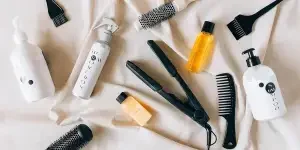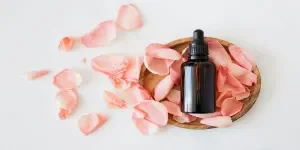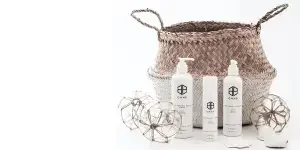If women have spent time doing their makeup, they’ll want it to stay in place—and that’s where setting spray comes in. This product helps prevent makeup from creasing, smudging, or wearing off too soon. But despite its simple goal, consumers have many options to choose from.
However, picking the wrong setting spray can worsen things, so retailers must understand some key points before deciding which options to stock. Keep reading to learn what to look for when choosing setting sprays in 2025.
Table of Contents
What is a setting spray?
Key ingredients in setting sprays
What to consider when stocking setting sprays
1. The consumer’s skin type
2. Longevity goals
3. Water-based vs. silicone-based setting sprays
4. Fragrance vs. fragrance-free
Setting spray vs. setting powder: What are the differences?
Choosing between a setting spray and a setting powder
1. Skin type
2. Desired finish
3. Makeup routine
Wrapping up
What is a setting spray?

Setting spray is a makeup product that helps cosmetics last longer. It usually comes in a spray bottle and is applied as a light mist over the face once consumers finish their makeup. Interestingly, it forms a thin, invisible layer that locks everything in, helping to stop makeup from smudging, creasing, or wearing off as the day progresses.
More importantly, there are many different setting sprays and mists, each made to suit different skin types and the kind of finish users want. For example, matte setting sprays help reduce oil and shine, while dewy ones give the skin a radiant look.
There are also hydrating sprays that add moisture, which is great for dry skin. Regardless of what consumers choose, they all offer similar benefits—helping their makeup last longer and keeping it looking fresh throughout the day.
Key ingredients in setting sprays
Here’s a quick breakdown of what you’ll often find in setting sprays and what each ingredient does:
- Water: Helps keep the skin hydrated and prevents the makeup from looking dry or cakey.
- Polymers: These create a thin, invisible layer over their makeup to lock everything in and protect it throughout the day.
- Alcohol: Some sprays contain alcohol, so they dry quickly. However, if consumers have dry or sensitive skin, retailers can offer them gentler alcohol-free options.
- Vitamins and botanicals: Many formulas include skin-loving extras like aloe vera, green tea extract, or Vitamin E to soothe and nourish the skin while keeping the makeup in place.
What to consider when stocking the best setting sprays
1. The consumer’s skin type

Setting spray can work well for most skin types, but offering the right one for consumers is key to getting the best results without irritation. This leads to the different setting sprays that provide specific benefits for various skin types, like controlling oil and shine (mattifying), adding moisture (hydrating), or giving the skin a healthy glow (illuminating).
As mentioned earlier, consumers with oily skin can use mattifying setting sprays to keep their shine under control while securing their makeup. On the other hand, those with dry skin will have a better experience with hydrating sprays (especially options with hyaluronic acid)—they add moisture and help stop makeup from sticking to dry areas. Now, if consumers have normal or combination skin, they can choose any finish without irritation.
2. Longevity goals

If consumers want their makeup to stay put no matter what, they will go for a setting spray labeled as waterproof or sweatproof. These formulas are made to lock everything in place and usually contain ingredients that help absorb oil and sweat, preventing them from ruining the makeup.
But if consumers are only looking for a lighter option that sets their makeup and tones down any powdery look, they’ll prefer setting sprays with skincare ingredients—they’ll keep things in place while being gentle on the skin.
3. Water-based vs. silicone-based setting sprays

If consumers like a fresh, lightweight feel to their makeup, retailers should consider offering them water-based setting sprays. They add a boost of hydration and give the skin a natural, healthy-looking finish. Even if they’re wearing a silicone-based foundation underneath, it usually won’t be a problem—the spray will sit nicely on top and help hold everything together without causing any issues.
On the other hand, a silicone-based setting spray is better for anyone looking for an extra-long-lasting hold. It forms a stronger barrier over the makeup, making it perfect for all-day wear. However, silicone has a heavier feel and won’t let the skin breathe as much. So, if consumers have sensitive or acne-prone skin, it’s better to use this spray for big events instead of every day.
4. Fragrance vs. fragrance-free

Scent can be a love-it-or-hate-it thing. Some people enjoy a light, fresh fragrance in their products, while others avoid anything scented altogether—especially if they have sensitive skin or are prone to irritation. That’s why it’s always a good idea to offer fragrance-free options. And if retailers still want to add scented sprays to their inventory, they should stick with soft, pleasant smells, nothing too strong or harsh.
Setting spray vs. setting powder: What are the differences?
Setting spray and powder help makeup last longer, but they work differently, and consumers use them differently. Setting powder is often the better option for controlling shine, especially in oily areas like the T-zone (forehead, nose, and chin). Although consumers can apply it all over their face, they shouldn’t use it too much to avoid their makeup looking dry or cakey.
Since it’s a loose or pressed powder, users will need a brush or sponge to apply it. On the other hand, setting sprays are easier to use since their bottles come with an applicator. Users won’t need extra brushes or sponges—they’ll only hold the bottle about 12 inches from their face and spray evenly. Another difference is that spraying too much will only take longer to dry, not making the makeup look cakey or dull.
Choosing between a setting spray and a setting powder
If consumers are unsure which one to choose, retailers can ask them to consider skin type, desired finish, and other products they want to use for their makeup.
1. Skin type
Consider the skin type as a good place to start when choosing between setting powder and sprays. If the consumer has oil or combination skin, they’ll have a better experience with setting powder, which can soak up excess oil and keep shine under control.
However, its compatibility is mostly limited to those skin types. On the other hand, setting sprays can work for all skin types, even if powders are better for oily skin. Even if consumers are worried about looking too shiny, they can go for a spray with a natural finish to lock in their makeup without making their skin look too dewy or greasy.
2. Desired finish
What kind of finish would the consumer want? If they like a smooth, shine-free look (almost like an airbrushed finish), setting powder is their best bet. It’s great for creating a matte look because it features ingredients that tackle oil, leaving the skin looking soft and velvety.
However, if their skin glows a little, they prefer setting sprays. They apply lightly, giving users a more natural, fresh-faced finish than powder. While powders mostly provide a matte look, setting sprays come in all kinds of finishes, including dewy, radiant, and natural, so it’s easier for consumers to find one they love.
3. Makeup routine
Another thing to consider is how detailed consumers want their makeup and how long they need it to last. Setting powder is great for more precise looks or when consumers want to put certain areas, like under the eyes. However, it can look cakey if consumers layer it over other powder products, like bronzer or blush.
Setting spray, in contrast, is quick and easy. Just a few spritzes, and the whole face is set for the day. It also works well over powder and liquid makeup, making it versatile enough to fit into almost any routine without messing up the look.
Wrapping up
Setting spray doesn’t just help makeup last longer—it also gives the skin a nice, refreshing pick-me-up during the day. A quick spritz can keep everything in place and make the face feel fresh again. And if consumers are worried about choosing between a spray and a powder, remind them they can use both products—what matters is which one they use first. Experts always recommend using setting sprays last to lock everything in place.



